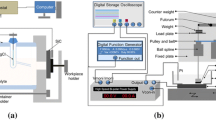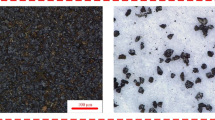Abstract
This study focused on the damaged layer of silicon carbide produced during polishing. For the experiment, 2-inch single-crystal 4H-SiC was used. In order to analyze the damaged layer, microscope methods such as transmission electron microscopy (TEM) and scanning electron microscopy (SEM) could be used. However, this study used nondestructive X-ray diffraction (XRD). The surface roughness value and surface image of the material before and after were confirmed using atomic force microscopy, and the full width at half maximum (FWHM) was measured using XRD. After mechanical polishing (MP), the depth of the damaged layer was 400 nm, and the corresponding FWHM value was 0.01711°. After 100 s of chemical mechanical polishing (CMP), the depth of the damaged layer was 69 nm and the corresponding FWHM value was 0.00444°. After 120 s of CMP, the depth of the damaged layer was 37 nm and the corresponding FWHM value was 0.00394°. The relationship between the surface roughness value and the FWHM was confirmed by comparing the values before and after each process. Furthermore, the SEM and TEM images enabled confirmation of the relationship between the damaged layer depth and the FWHM.












Similar content being viewed by others
References
Ji, S., Zhang, Z., & Wang, F. (2017). Overview of high voltage SiC power semiconductor devices: Development and application. CES Transactions on Electrical Machines and Systems, 1(3), 254–264.
Lee, H. S., et al. (2010). Hybrid polishing mechanism of single crystal SiC using mixed abrasive slurry (MAS). CIRP Annals-Manufacturing Technology, 59(1), 333–336.
Qiusheng, Y., et al. (2015). Surface and subsurface cracks characteristics of single crystal SiC wafer in surface machining. AIP Conference Proceedings, 1653(1), 020091.
Lee, H. S., Sung, I. H., et al. (2019). Chemical mechanical polishing: A selective review of R&D trends in abrasive particle behaviors and wafer materials. Tribology and Lubricants, 35(5), 274–285.
Lee, H., et al. (2009). The effect of mixed abrasive slurry on CMP of 6H-SiC substrates. Journal of Ceramic Processing Research, 10(3), 378–381.
Park, J. H., & Lee, W. J. (2010). Single crystal growth method and application of silicon carbide (SiC). The Korean Ceramic Society, 13(6), 64–74.
Lee, B. C. (2015). Development status of SiC (silicon carbide) based high output power device manufacturing technology. The Institute of Electronics and Information Engineers, 42(1), 18–27.
Shin, D. G., et al. (2019). Study on the growth of 4H-SiC single crystal with high purity SiC fine powder. Journal of the Korean Crystal Growth and Crystal Technology, 29(6), 383–388.
Bobea, M., et al. (2013). X-ray characterization techniques for the assessment of surface damage in crystalline wafers: A model study in AlN. Journal of Applied Physics, 113(12), 123508.
Moram, M. A., & Vickers, M. E. (2009). X-ray diffraction of III-nitrides. Reports on Progress in Physics, 72(3), 036502.
Takagi, H., et al. (2004). XRD analysis of carbon stacking structure in coal during hear treatment. Fuel, 83(17), 2427–2433.
Lim, G., et al. (1987). Grazing incidence synchrotron X-ray diffraction method for analyzing thin films. Journal of Materials Research, 2(4), 471–477.
Jia, R.-X., et al. (2010). Calculation of dislocation density using X-ray diffraction for 4H-SiC homoepitaxial layers. Spectroscopy and Spectral Analysis, 30(7), 1995–1997.
Anzalone, R., et al. (2018). Stress relaxation mechanism after thinning process on 4H-SiC substrate. Materials Science Forum, 924, 535–538.
ISO 4288:1996 Geometrical Product Specifications (gps). (1996). Surface texture: Profile method. Rules and procedures for the assessment of surface texture. Genève: ISO.
Acknowledgements
This work was supported by a grant-in-aid from the Presidential Committee for Balanced National Development and Busan Metropolitan City (Project No. B0071016000042).
Author information
Authors and Affiliations
Corresponding author
Additional information
Publisher's Note
Springer Nature remains neutral with regard to jurisdictional claims in published maps and institutional affiliations.
Rights and permissions
Springer Nature or its licensor holds exclusive rights to this article under a publishing agreement with the author(s) or other rightsholder(s); author self-archiving of the accepted manuscript version of this article is solely governed by the terms of such publishing agreement and applicable law.
About this article
Cite this article
Jung, H., Jeong, S., Park, Y. et al. X-ray Diffraction Analysis of Damaged Layer During Polishing of Silicon Carbide. Int. J. Precis. Eng. Manuf. 24, 25–32 (2023). https://doi.org/10.1007/s12541-022-00711-5
Received:
Revised:
Accepted:
Published:
Issue Date:
DOI: https://doi.org/10.1007/s12541-022-00711-5




